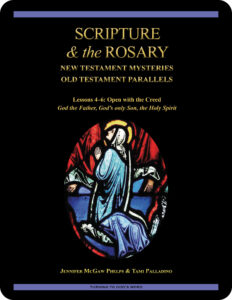 Scripture & the Rosary:
Scripture & the Rosary:
New Testament Mysteries,
Old Testament Parallels
The Creed
Lesson 6 The Holy Spirit: Sanctification & Love
the First Letter of Paul to the Corinthians 13:1–10
the First Letter of Paul to the Corinthians 13:12–13
the book of Genesis 46:26–30
Revised Standard Version Catholic Edition (RSVCE)*
New American Bible Revised Edition (NABRE)*
Catechism of the Catholic Church
Rosarium Virginis Mariae (Rosary of the Virgin Mary)
ex libris (in our library)
cross references for Scripture & the Rosary
glossary for Scripture & the Rosary
next lesson: The Angel Gabriel Was Sent to a Virgin
This material coordinates with Lesson 6 on pages 20–23 in Scripture & the Rosary: New Testament Mysteries, Old Testament Parallels.
And Mary said, “My soul magnifies the Lord, and my spirit rejoices in God my Savior,
for he has regarded the low estate of his handmaiden.
For behold, henceforth all generations will call me blessed;
for he who is mighty has done great things for me, and holy is his name.”
—the Gospel According to Luke 1:46–49
welcome to our in-depth study of Scripture & the Rosary
We invite groups and individuals to become acquainted with Turning to God’s Word Catholic Bible  studies through
studies through  Scripture & the Rosary: New Testament Mysteries, Old Testament Parallels, which has been granted an imprimatur. Although no longer available in print, the first six lessons can be downloaded from our website. The remaining 20 lessons are posted throughout the liturgical year along with their related online study pages. Click here to access Lesson 4 through Lesson 6. If you have a Bible-related question or comment, you can use one of the “ask us your question” or “what do you think” buttons on any online study page to contact our authors.
Scripture & the Rosary: New Testament Mysteries, Old Testament Parallels, which has been granted an imprimatur. Although no longer available in print, the first six lessons can be downloaded from our website. The remaining 20 lessons are posted throughout the liturgical year along with their related online study pages. Click here to access Lesson 4 through Lesson 6. If you have a Bible-related question or comment, you can use one of the “ask us your question” or “what do you think” buttons on any online study page to contact our authors.
open with prayer
It’s always wise to begin any Bible study with prayer, whether reading the Scriptures alone or meeting with others in a discussion group. You can pray using your own words or use one of the opening prayers on our website. We especially like the following:
Lord Jesus, you promised to send your Holy Spirit to teach us all things.
As we read and study your word today,
allow it to touch our hearts and change our lives. Amen.
a picture of divine & human love
 The image of the Blessed Virgin Mary that appears on the cover of Scripture & the Rosary: New Testament Mysteries, Old Testament Parallels comes from the primary panel in the window that inspired Lesson 6—”The Holy Spirit: Sanctification and Love.” The representation of the Holy Spirit as a dove that appears at the top of our website is taken from this window. The secondary panel looks at the expression of love between Joseph and Jacob
The image of the Blessed Virgin Mary that appears on the cover of Scripture & the Rosary: New Testament Mysteries, Old Testament Parallels comes from the primary panel in the window that inspired Lesson 6—”The Holy Spirit: Sanctification and Love.” The representation of the Holy Spirit as a dove that appears at the top of our website is taken from this window. The secondary panel looks at the expression of love between Joseph and Jacob  described in the book of Genesis 46:26–30. Clicking on the New and Old Testament stained glass window art will enlarge it. The same art illustrates Lesson 6 in Scripture & the Rosary: New Testament Mysteries, Old Testament Parallels. Our in-depth Catholic Bible study In the Beginning: The Book of Genesis provides more information about these important early patriarchs of the Old Testament.
described in the book of Genesis 46:26–30. Clicking on the New and Old Testament stained glass window art will enlarge it. The same art illustrates Lesson 6 in Scripture & the Rosary: New Testament Mysteries, Old Testament Parallels. Our in-depth Catholic Bible study In the Beginning: The Book of Genesis provides more information about these important early patriarchs of the Old Testament.
making connections between the new & the old
Consider what there is about the love between Jacob and his son Joseph that resembles the love between God the Father and Jesus the Son.
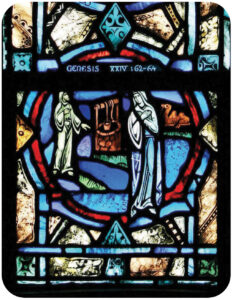 ? Why do you think it is that the artist of these stained glass windows chose the Old Testament patriarchs’ love for each other as a parallel to the divine love depicted in the primary panel of this window?
? Why do you think it is that the artist of these stained glass windows chose the Old Testament patriarchs’ love for each other as a parallel to the divine love depicted in the primary panel of this window?
 ? Is there a different Old Testament scene that you would have chosen instead?
? Is there a different Old Testament scene that you would have chosen instead?
? Sanctification and love are themes of this lesson. Refer to the vocabulary box on page 23 in Scripture & the Rosary: New Testament Mysteries, Old Testament Parallels for greater understanding of sanctification. How are sanctification and love related to the action of the Holy Spirit in the world and in the Church?
? How are sanctification and love related to the action of the Holy Spirit in your own life?
? What can you do to be more loving?
? How might following the teaching about love in the First Letter of Paul to the Corinthians 13:1–10 and 13:12–13 lead to sanctification?
? What do you think it is that elevates love to a theological virtue?
? How is it that men and women can aspire to love in this way?
supplemental Scripture
Not everyone is acquainted with the Old Testament parallels in Scripture & the Rosary: New Testament Mysteries, Old Testament Parallels.  This lesson emphasizes the third person of the Blessed Trinity and ties the action of the Holy Spirit to love and sanctification. The Scripture passages chosen to illustrate this in the stained glass window panels are from the forty-sixth chapter of the book of Genesis and the thirteenth chapter of the First Letter of Paul to the Corinthians.
This lesson emphasizes the third person of the Blessed Trinity and ties the action of the Holy Spirit to love and sanctification. The Scripture passages chosen to illustrate this in the stained glass window panels are from the forty-sixth chapter of the book of Genesis and the thirteenth chapter of the First Letter of Paul to the Corinthians.
a saint’s view of what motivates the Church
St. Thérèse of Lisieux saw eternal love alone as the motivating force that enables all members of the Church to act: “If love ceased to function, apostles would forget to preach the Gospel, and martyrs would refuse to shed their blood.”
 Paraclete—you could look this up in our archives
Paraclete—you could look this up in our archives
The Holy Spirit usually is represented in art by a dove, but the Scriptures use a variety of other images—fire, wind, and a legal counselor. To learn about the Holy Spirit as Paraclete, read Lost in Translation, an online column in which Turning to God’s Word author Matthew Phelps helps readers connect with ideas expressed in the original languages of the Scriptures. New Lost in Translation entries are posted on  Mondays, and past entries are archived on our website. Contact us if you’d like to receive Lost in Translation by email every week. You can learn more about what Jesus taught concerning the Holy Spirit in Lesson 19 When the Spirit of Truth Comes in the Turning to God’s Word Catholic Bible study The Gospel According to John: An Encounter with Grace & Truth.
Mondays, and past entries are archived on our website. Contact us if you’d like to receive Lost in Translation by email every week. You can learn more about what Jesus taught concerning the Holy Spirit in Lesson 19 When the Spirit of Truth Comes in the Turning to God’s Word Catholic Bible study The Gospel According to John: An Encounter with Grace & Truth.
the colors have meaning
“Colors Help Tell the Stories” on page 23 in Scripture & the Rosary: New Testament Mysteries, Old Testament Parallels explains how the different colors used in religious stained glass windows reinforce the meaning behind the biblical scenes.
the best Catholic commentary about Scripture
 To find out more about how Church teaching is supported by passages in Scripture & the Rosary: New Testament Mysteries, Old Testament Parallels, check out the Index of Citations in the Catechism of the Catholic Church. Links to the primary Scripture passages in the lesson (Revised Standard Version Catholic Edition [RSVCE*]) and relevant paragraphs in the Catechism are provided here. Not every passage in the biblical text for this study is referenced in a Catechism paragraph, however, including the passage in this lesson from the book of Genesis 46:26–30.
To find out more about how Church teaching is supported by passages in Scripture & the Rosary: New Testament Mysteries, Old Testament Parallels, check out the Index of Citations in the Catechism of the Catholic Church. Links to the primary Scripture passages in the lesson (Revised Standard Version Catholic Edition [RSVCE*]) and relevant paragraphs in the Catechism are provided here. Not every passage in the biblical text for this study is referenced in a Catechism paragraph, however, including the passage in this lesson from the book of Genesis 46:26–30.
the First Letter of Paul to the Corinthians 13:1–4—paragraph 1826
the First Letter of Paul to the Corinthians 13:1–13—paragraphs 735, 800
the First Letter of Paul to the Corinthians 13:4–7—paragraph 1825
the First Letter of Paul to the Corinthians 13:5—paragraph 953
the First Letter of Paul to the Corinthians 13:8—paragraph 773
the First Letter of Paul to the Corinthians 13:12—paragraphs 163, 164, 314, 1023, 1720, 2519
the First Letter of Paul to the Corinthians 13:13—paragraphs 1813, 1826, 1841
ways our glossary might prove helpful
In addition to providing extra information about geographical locations, our glossary also points out  when a person or place is mentioned in the biblical text under more than one name or more than one spelling. If you can remember a name but aren’t sure in which lesson it shows up, you can find it in the glossary, which lists every proper noun that appears in the primary biblical text in Scripture & the Rosary: New Testament Mysteries, Old Testament Parallels.
when a person or place is mentioned in the biblical text under more than one name or more than one spelling. If you can remember a name but aren’t sure in which lesson it shows up, you can find it in the glossary, which lists every proper noun that appears in the primary biblical text in Scripture & the Rosary: New Testament Mysteries, Old Testament Parallels.
to learn more, read more Scripture
When you’re having difficulty understanding a passage of Scripture, it can help to read the  cross references—but looking these up takes time. We’ve compiled the cross references from the Revised Standard Version Second Catholic Edition (RSV2CE)—the same translation that we reprint in our study books. The list can be found at the top of every supplemental study page in this study, and it includes links to cross references in the primary biblical texts for all of the lessons in Scripture & the Rosary: New Testament Mysteries, Old Testament Parallels.
cross references—but looking these up takes time. We’ve compiled the cross references from the Revised Standard Version Second Catholic Edition (RSV2CE)—the same translation that we reprint in our study books. The list can be found at the top of every supplemental study page in this study, and it includes links to cross references in the primary biblical texts for all of the lessons in Scripture & the Rosary: New Testament Mysteries, Old Testament Parallels.
don’t forget about our indexes & extra online material

 If you’re trying to locate information about a Scripture passage, you can look it up in the index at the back of the online version of this study. If you want to revisit a commentary, you can look it up by title in the topics index. If you want to learn more about another book of the Bible for which there’s a Turning to God’s Word study, you can read online commentaries and watch any accompanying videos by choosing a lesson from one of the study directories. (There are no lesson videos with Scripture & the Rosary: New Testament Mysteries, Old Testament Parallels.) Finally, if you have a question or would like to make a comment about any of our studies, you can use the “ask us your question” or “what do you think” button to email our authors.
If you’re trying to locate information about a Scripture passage, you can look it up in the index at the back of the online version of this study. If you want to revisit a commentary, you can look it up by title in the topics index. If you want to learn more about another book of the Bible for which there’s a Turning to God’s Word study, you can read online commentaries and watch any accompanying videos by choosing a lesson from one of the study directories. (There are no lesson videos with Scripture & the Rosary: New Testament Mysteries, Old Testament Parallels.) Finally, if you have a question or would like to make a comment about any of our studies, you can use the “ask us your question” or “what do you think” button to email our authors.
ex libris—Church documents & books about religious topics
Link to magisterial documents referred to in our Bible studies at ex libris—magisterial documents.  This listing includes significant recent encyclicals as well as a number of historical Church documents. Recommended books related to Scripture study can be found at ex libris—main bookshelf.
This listing includes significant recent encyclicals as well as a number of historical Church documents. Recommended books related to Scripture study can be found at ex libris—main bookshelf.
wondering how to pronounce some of these words?
The following links are to readings from the New International Version (NIV) Bible. To listen, click on the audio icon above the printed text. Although not taken from the translations used in our study materials, the NIV readings provide an audio guide to pronunciation of words in this lesson’s primary biblical texts. A close online version of the translation of the Bible used in Catholic liturgy in the United States as well as an audio guide for daily Mass readings for the current month can be found on the website of the United States Conference of Catholic Bishops (USCCB).
the First Letter of Paul to the Corinthians 13:1–10 (NIV)
the First Letter of Paul to the Corinthians 13:12–13 (NIV)
the book of Genesis 46:26–30 (NIV)
pray the Rosary
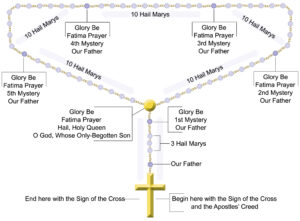 We invite you to pray the Rosary along with Turning to God’s
We invite you to pray the Rosary along with Turning to God’s  Word co-founder Tami Palladino and her daughter Anne Marie. Their videos are available on the online study pages for Lessons 7 through 26, and the Rosary prayers as well as the videos for all 20 mysteries are accessible year-round at how to pray the Rosary. Clicking on the diagram (right) will take you to the website page with the Rosary prayers. Watch Tami and Anne Marie’s how-to video (below) to learn more about praying the Rosary.
Word co-founder Tami Palladino and her daughter Anne Marie. Their videos are available on the online study pages for Lessons 7 through 26, and the Rosary prayers as well as the videos for all 20 mysteries are accessible year-round at how to pray the Rosary. Clicking on the diagram (right) will take you to the website page with the Rosary prayers. Watch Tami and Anne Marie’s how-to video (below) to learn more about praying the Rosary.
Lesson 7 The Angel Gabriel Was Sent to a Virgin (the First Joyful Mystery, the Annunciation)—the Gospel According to Luke 1:26–35 and the First Book of Samuel 1:9–17
Lesson 5 God’s Only Son: Redemption & Hope—the Letter to the Hebrews 6:13–20, the book of Genesis 24:58–60, and the book of Genesis 24:62–67
you also may like our study of the book of Genesis
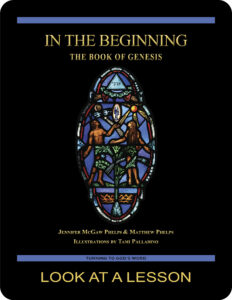 The first seven lessons of In the Beginning: The Book of Genesis, a 28-lesson Catholic Bible study with an imprimatur, provide an in-depth look at the very earliest biblical history—including the two accounts of Creation, events surrounding the Fall of Adam and Eve, the relationship between Cain and Abel, and the baptismal foreshadowing present in the account of Noah and the Flood. Remaining lessons look at lives of the patriarchs Abraham, Isaac, Jacob, and Joseph. Click on the book’s cover to view a sample lesson.
The first seven lessons of In the Beginning: The Book of Genesis, a 28-lesson Catholic Bible study with an imprimatur, provide an in-depth look at the very earliest biblical history—including the two accounts of Creation, events surrounding the Fall of Adam and Eve, the relationship between Cain and Abel, and the baptismal foreshadowing present in the account of Noah and the Flood. Remaining lessons look at lives of the patriarchs Abraham, Isaac, Jacob, and Joseph. Click on the book’s cover to view a sample lesson.
start a Turning to God’s Word Bible study
Thank you for your interest in Scripture & the Rosary: New Testament Mysteries, Old Testament Parallels. 
 Information about beginning a Turning to God’s Word Bible study can be found at start a Bible study. Tami, Matthew, and I are available to answer your questions and to offer support. You may use this email to contact us directly if you’re interested in starting a Turning to God study or in having your study schedule listed with other TtGW study groups on our website. —Jennifer
Information about beginning a Turning to God’s Word Bible study can be found at start a Bible study. Tami, Matthew, and I are available to answer your questions and to offer support. You may use this email to contact us directly if you’re interested in starting a Turning to God study or in having your study schedule listed with other TtGW study groups on our website. —Jennifer
*There are seven deuterocanonical books in the Old Testament—the Books of Tobit, Judith, Wisdom, Sirach, Baruch, and First and Second Maccabees, as well as some passages in the Books of Esther and Daniel. Protestants usually refer to these works as “apocryphal,” a word that means “outside the (Protestant) canon” because they’re excluded from most Protestant Bibles. The word “deuterocanonical” means “second canon”; Catholics use that word to refer to any section of the Catholic Old Testament for which there are no extant, or existing, Hebrew manuscripts. All of the deuterocanonical books appear in the Septuagint, the earliest remaining versions of which date to the 1st century B.C. This Greek translation of the Old Testament was in common use by Jews at the time of Jesus. Learn more by reading How Do Catholic & Protestant Bibles Differ?
Turning to God’s Word printed Bible studies use the 2006 Revised Standard Version Second Catholic Edition (RSV2CE) translation for all Scripture references except those to the Psalms, which are taken from The Abbey Psalms and Canticles, prepared by the Benedictine monks of Conception Abbey and published in 2020 by the United States Conference of Catholic Bishops (USCCB). All Scripture links for the digital version of Scripture & the Rosary: New Testament Mysteries, Old Testament Parallels are to the 1966 Revised Standard Version Catholic Edition (RSVCE) translation. The New International Version (NIV) audio recordings follow the same chapter and verse numbering as the RSV Catholic translations, but the NIV translation doesn’t include the deuterocanonical books and passages.
The 1966 RSVCE uses archaic pronouns and verb forms such as “thee,” “thou,” “didst” in the Psalms and in direct quotations attributed to God. The 2006 RSV2CE replaces these with more accessible English. The few significant translation changes in the RSV2CE include rendering almah as “virgin” in the Book of Isaiah 7:14 and restoring the term “begotten” in the Gospel According to John 3:16.
Numbering varies for some passages in this Bible study. Turning to God’s Word studies follow the numbering in the Revised Standard Version Catholic translations (RSV2CE and RSVCE). Discrepancies in the New American Bible Revised Edition (NABRE) are noted in the Index of Scripture Citations.
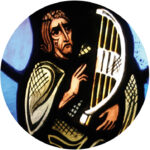 You can learn more about the Psalms by viewing a sample lesson from the Turning to God’s Word Catholic Bible study Sing a New Psalm: Communicating with God Through the Prayers of the Church—Volume I: Lauds & Vespers. The second part of that study, Sing a New Psalm: Communicating with God Through the Prayers of the Church—Volume II: Vigils, Day Prayer & Compline, is scheduled for publication in 2025. Some verse numbers may vary in different translations of the Psalms.
You can learn more about the Psalms by viewing a sample lesson from the Turning to God’s Word Catholic Bible study Sing a New Psalm: Communicating with God Through the Prayers of the Church—Volume I: Lauds & Vespers. The second part of that study, Sing a New Psalm: Communicating with God Through the Prayers of the Church—Volume II: Vigils, Day Prayer & Compline, is scheduled for publication in 2025. Some verse numbers may vary in different translations of the Psalms.
